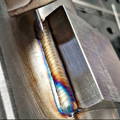
ANDREW RIPAMONTI
Oct 1, 2022
Welding Stainless Steel the Right Way: A Comprehensive Guide
Are you a professional welder looking to take your skills to the next level? A hobbyist looking to lay down some badass welds on a personal project? Do you frequently work with or are interested in working with stainless steel products and materials? In this guide we will review the ins and outs of welding stainless steel.
Although welding stainless steel might be challenging compared to other materials, it is a skill well worth the effort. When done properly, stainless steel welding will yield very impressive results. With a little practice, a healthy dose of elbow grease, and the desire to learn, you will be welding stainless steel in no time. (Keep scrolling, there's a lot more to read!)

"Meticulous prep, high quality material, and proper basic techniques will ensure perfect stainless steel welds."
Can You Weld Stainless Steel?
Before we dive in, let’s address the elephant in the room. “Can you weld stainless steel?” is a question we’ve heard more times than we have fingers to count on.
The simple answer is, "YES!".
Welding stainless steel isn’t just doable, with the right approach and techniques it can result in a high-quality weld you’ll be proud of. But make sure you take your time and are meticulous with your methods. Fail to approach this material in the right way and the results can be disappointing.

Welder: @sardinian_welder - Instagram
What is Stainless Steel?
Let's start with the basics. What is stainless steel?
Understanding exactly what stainless steel is can help provide some much-needed context when working with the material.
Long revered for its ability to withstand corrosion, maintain an illustrious shine, and durability, stainless steel is an iron-based metal alloy. This alloy contains varying percentages of chromium, the primary element responsible for the metal’s rust-resistant notability. The specific amount of chromium used in the blend often varies widely, from as little as 11% all the way up to 30%.
Given its high resistance to tarnishing, corrosion, and high and low temperatures, stainless steel has long been a favorite among many industries ranging from oil and gas, automotive, biopharmaceutical manufacturing, and so many more.
Other industries, such as food and beverage appreciate the ability of stainless steel to naturally resist microbial growth. This reigns true for the medical field as well.
But all of these benefits come at a price. These metals are on the higher end of the price spectrum. In some cases costing up to 3-5x that of traditional steel applications. With material waste resulting in significant budget overages, getting each weld right is a paramount concern.

Welder: @markus_lohrer - Instagram
Types of Stainless Steel That Can Be Welded
Within the category of stainless steel, we have several unique types. Each is categorized based on its molecular structure and composition. Every type of stainless steel has its pros and cons and may be more suitable for one application vs another. Let's review them!
The Most Common Types of Stainless Steel Used in Fabrication Shops
Austenitic Stainless Steel: Typically contains between 16-30% chromium combined with between 2-20% nickel. This combination results in enhanced formability, improved surface quality, and additional resistance to wear and corrosion. However, this steel cannot be ‘hardened’ by heat treatment. Applications include domestic, industrial, transport, and architectural products.
Martensitic Stainless Steel: Notable for its hardness (when heat-treated) and for its strength. These alloys typically are comprised of 11-17% chromium combined with around 0.15-0.63% carbon. The material can be easily formed and bent to spec, and is magnetic. Common applications for this material include industrial blades, springs, medical and dental instruments, cook wear, cutlery, pliers, scissors, and more.
Ferritic Stainless Steel: Often used for its high resistance to both corrosion and elevated temperature oxidation. Ferritic stainless steel is stronger than most carbon steels. This makes it ideal for applications where weight reduction and/or thinner materials are called for. Often containing between 10-30% chromium, this steel is not capable of hardening under heat. Common applications include those in the automotive, appliance, food equipment, and petrochemical industries.
Types of Stainless Steel That Can Be Welded
Within the category of stainless steel, we have several unique types. Each is categorized based on its molecular structure and composition. Every type of stainless steel has its pros and cons and may be more suitable for one application vs another. Let's review them!
The Most Common Types of Stainless Steel Used in Fabrication Shops
Austenitic Stainless Steel: Typically contains between 16-30% chromium combined with between 2-20% nickel. This combination results in enhanced formability, improved surface quality, and additional resistance to wear and corrosion. However, this steel cannot be ‘hardened’ by heat treatment. Applications include domestic, industrial, transport, and architectural products.
Martensitic Stainless Steel: Notable for its hardness (when heat-treated) and for its strength. These alloys typically are comprised of 11-17% chromium combined with around 0.15-0.63% carbon. The material can be easily formed and bent to spec, and is magnetic. Common applications for this material include industrial blades, springs, medical and dental instruments, cook wear, cutlery, pliers, scissors, and more.
Ferritic Stainless Steel: Often used for its high resistance to both corrosion and elevated temperature oxidation. Ferritic stainless steel is stronger than most carbon steels. This makes it ideal for applications where weight reduction and/or thinner materials are called for. Often containing between 10-30% chromium, this steel is not capable of hardening under heat. Common applications include those in the automotive, appliance, food equipment, and petrochemical industries.
"Welding stainless steels always requires the proper tools, correct heat, and appropriate applications to get it right."
Is Welding Stainless Steel Hard?
One could argue that proper welding is a challenging task no matter the material. Always requiring the proper tools, correct heat, and appropriate applications to get it right. And don't forgot a lot of practice!
But is welding stainless steel any more difficult than other materials?
For the beginner, yes. This type of steel tends to retain heat more efficiently than other alloys, making it more prone to warping under high temps. This can often lead to shape distortion when cooling.
As far as aesthetics go, when a clean good-looking weld is a requirement, stainless steel can be quite unforgiving. Every scratch and blemished area is left glaringly in your face. For this reason, practice, control, and preparation are key.
"MIG welding stainless steel is appropriate when speed and efficiency are of utmost importance."
What Type of Welding Is Best for Stainless Steel?
It depends.
No, that’s not a cop-out. It really does matter what kind of result you are looking for. While some jobs will be best suited to MIG welding, for others, TIG welding might be a better fit. Let’s take a closer look at your options below…
Can You TIG Weld Stainless Steel?
TIG Welding, also known as Gas Tungsten Arc Welding, is suitable for welds where precision and maximum strength is key. TIG welding is often preferred when you need clean, controlled welds with little margin for error.
But all these fancy looking welds come at a price: time. TIG welding is a slow, meticulous process and might not be a good fit when deadlines need to be hit or when mass-producing products.
Can You MIG Weld Stainless Steel?
MIG Welding, also known as Shielded Metal Arc Welding, is a better-suited approach when finesse isn’t as important as speed and efficiency. Utilizing simple equipment and easy processes, MIG welding machines can be easily transported for on-location welds. This means MIG welding is a flexible approach for mechanical repairs and fabrication work.
"Having a separate set of tools, proper cleaning, and avoiding carbon steel are key tips to ensure a proper stainless steel weld."
The Key to Getting a Stainless Steel Weld Right: Preparation
Like most things in life, a little preparation is key, and always pays off.
Separate Tools
To begin, you should have a separate set of tools for cleaning and prepping your stainless steel prior to welding. Stainless steel can be easily affected by even the slightest amount of carbon steel in the mix. This means cross-contamination of residual carbon steel from your other tools or machines (even in trace amounts) can end up embedded in your weld. This is turn can affect the final product.
Proper Cleaning
Hammers, clamps, and any tools that will come in contact with your stainless steel should be spotless prior to beginning work. Similarly, cleaning your stainless-steel materials can also ensure no foreign particles or residue makes its way into the weld.
Avoid Working with Carbon Steel In the Same Space
High impact work on carbon steels, such as hammering or grinding can leave carbon steel particulates in the air. These particles can land and make their way into your stainless steel. This can negatively affect the integrity of your weld and increase the risk of corrosion.
Pro Tips for Welding with Stainless Steel
Warping and distortion is a real concern when welding stainless steel. In order to combat this, you’ll need to clamp a piece of aluminum, copper or brass (NOT CARBON STEEL) behind the seam of the weld. Doing so will act as a heat sink. This will effectively cool the weld temperature, while reducing the risk of burn-through.
Actively Monitoring the Temperature
Both the temperature of the base metal and weld metal should be kept under close watch. Any divergence from the desired ranges can result in issues.
Suggested Methods of Measuring Temperature Include:
-Temperature-indicating sticks
-Electronic infrared thermometers
-Electronic surface temperature probes

Welder: @sardinian_welder - Instagram
Welding with Various Types of Stainless Steel
Welding with Stainless Steel: A Skill Worth the Effort
